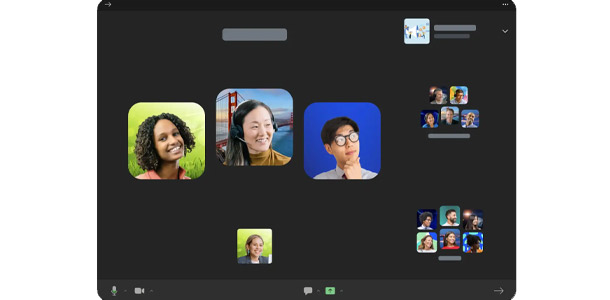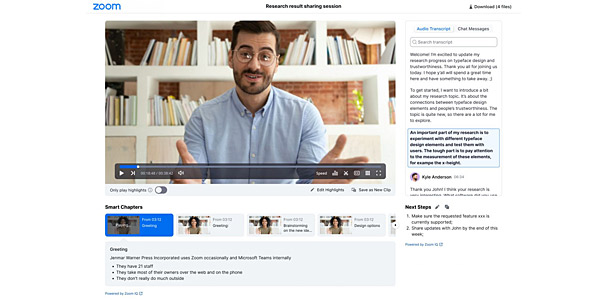| |
|
| |
| It didn’t have to be this way. Hearts go out to employees of Twitter, Meta, and other companies who lost their jobs because of sweeping market corrections and CEO hubris. Ultimately, these talented employees will be fine. We have our job board and some programming to help. |
|
|
| |
|
|
| |
| Decemberr 15, 2022 | 2:30 pm EST | ZOOM |
| |
|
|
|
| |
If the only tool you have is a hammer, you see every problem as a nail.” That’s why we’re getting together on Dec 15th at 2:30 EST to share our notes about using the right tool for the right job. Jeremy Caplan, Director of Teaching and Learning at CUNY's Newmark Graduate School of Journalism and creator of the Wonder Tools blog, will show us a few of his favorites. But don’t come empty hand-handed. Bring a fistful of your favorites, too. |
| |
|
|
| |
|
| |
| Zoom Adds Tons of Features, But Is Ease of Use One of Them? |
|
| |
Zoomtopia’s gala 2-day event ended last week with a flurry of announcements that positions Zoom as much more than a video-conference platform. The overarching theme is the future of work. The buckets of announcements can generally be divided into work/home collaborations; meetings and events; calendar and email; and partnerships. |
| |
 |
| Eric Yuan, Zoom’s CEO, runs through the gamut of feature additions at Zoomtopia 2022. Image credit: Zoom |
| |
|
| |
Email and Calendars
Normally you’d start your Zoom life in Google Calendar or Microsoft Outlook, jumping back and forth, inviting and emailing various attendees to events. In beta test now, Zoom announced full email and calendar integration, which means you’ll be able to set up your meetings without ever having to leave the Zoom environment.
As is often the case, Zoom has to release multiple versions of its features depending on how users plan on integrating them. Smaller businesses will probably want to work from the Zoom calendar directly. Larger companies may want to integrate it into their existing calendars. As often happens, one of Zoom’s biggest challenges is their tutorials. |
| |
 |
Beta version of the calendar and email integration without leaving Zoom.
Image credit: Zoom |
| |
|
| |
Work/Home Collaborations
Betting that many of us will never all be in the office at the same time, Zoom’s biggest features released at Zoomtopia have to do with the remote office. None are so novel that you couldn’t find other apps to get the same results. But Zoom is counting on its massive reach and footprint to grow its market. Many of the
features will ultimately go under the umbrella of Zoom One, the centralized Zoom offering featuring chat services, a shared whiteboard, dedicated chat rooms, and more. |
| |
|
| |
Zoom Spaces
Think of Clubhouse meets Slack; Zoom Spaces is a water cooler for hybrid workers. Spaces is a persistent hangout/gathering space for your employees, friends, and clubs to gather. And it works well for hybrid gatherings of remote or on-site workers. There’s currently a 13-person limit. Zoom calls it a ”forever hangout” for impromptu Zoom
meetings. You can create groups to send messages, videos, or meeting invites. |
| |
 |
| Zoom Spaces is your forever hangout. Image credit: Zoom |
| |
|
| |
Events and Meetings
Smart Recordings add intelligence to Zoom recording. Much like YouTube and others, Zoom divides the recorded video from longer meetings into smaller chapters and creates a summary of the meeting. Transcriptions are nice and make videos easier to edit. |
| |
 |
Zoom’s Smart Recordings make post-meeting editing easier.
Image credit: Zoom |
| |
|
| |
Cosmetics
New templates let you have more control of the branding of your events. The addition of more avatars seems a bit superfluous, but maybe not to someone who loves avatars. Intelligent Director is like Zoom’s Spotlighting feature on steroids. It allows you to control multiple cameras with AI to create the best view of a speaker. It can adjust as the speaker
moves.
Other event improvements include optimization with Zoom Mesh, the company’s own eCDN. There are also several new ways to engage or present content, including Simulive to make recorded webinars more engaging. Plus, Zoom now has a notable partnership with Cvent to create better hybrid events.
On other fronts, Zoom is also getting serious about the customer support market, announcing the Zoom Virtual Agent, which is a conversational AI chatbot that uses natural language processing and machine learning to resolve customer issues. When it launches early next year, the virtual agent can be fully integrated with Zoom Contact Center or be used as a
standalone chatbot solution. |
| |
|
| |
What’s Missing?
I’d love to see more integration with social media so you could edit a clip and share to social networks without leaving Zoom. How about easier restream buttons and better invitation management? And a plea for Zoom to start afresh documenting its solutions and features because as the feature set grows, so does FUD. |
| |
 |
| Meme of the week. Image credit: Mike Hiskey’s LinkedIn page |
| |
|
 |
| |
|
|
| |
First comes the hype, often followed by doubt. Lots of folks attribute the birth of the metaverse to Snowcrash, the Neal Stephenson science fiction book. My perspective is that our technologies were heading towards the underpinnings of a Web 3,
immersive, shared experience, but it was pandemic fever that escalated it from niche to the mainstream conversation. For one, game developers had lots of time to envision new worlds. Second, the pandemic put the spotlight on our reliance on social media to stay connected, but it also left us feeling abused as it became obvious we were mere “products” being sold to
advertisers. Two years of lockdown, too much screen time, and a need for escapism caused many of us to drink a little metaverse Kool-Aid.
This past month was sobering, even for Kool-Aid imbibers. Many of us have visited the metaverse as it currently exists, and have left underwhelmed. Tech companies, most notably Mark Zuckerberg’s Meta, have been taken to task over everything from lifeless avatars in Horizon Worlds to its stock valuations.
Plus, at this moment you have people spending less time video gaming. There’s a new euphoria about being in the real world again.
Disappointing metaverse experiences and ghost towns tell us that people are humans even in the metaverse. They need curation and they need something to “do” besides wander. These failures will inform us to iterate.
Sir Tim Berners Lee, one of the best-known creators of the original World Wide Web, spoke at the Web Summit in Lisbon about his vision for
Web3 and his new project SOLID that sees Web3 as a place that lets you work and play with your personal data all stored in one place. Michael Wolfe created a chart based on Google Trends that indicates the Metaverse has reached its peak hype cycle – finally – after 20 years All of the major technologies are ready to enable things like digital twins, watch parties, personal
avatars, travel experiences, entertainment, and more. In other words, the backlash is temporary. Keep building and experimenting. |
| |
|
| |
|
 |
| |
Adobe Gets A New Challenger
If you’ve watched professional colleagues labor with Photoshop and said, “Wish I could do that” then you might want to look at PhotoRoom. Formerly known as Imagen, PhotoRoom is an AI-assisted program that performs a variety of Photoshop-like tasks, including removing or changing backgrounds. |
| |
|
| |
Rethinking Asynchronous Events
Michael Hiskey, Chief Strategy Officer at Engagez, argues that the physical and the online portion of a gathering will find the most value in the asynchronous hybrid virtual event. It all boils down to understanding the new timing of an
event. In a lengthy but provocative essay, he dissects the factors of revenue, timeliness, and how to make online viewers feel part of the action. Read the full essay. |
| |
|
| |
TechsyTalk
If you missed last week’s TechsyTalk Global with Liz King Caruso, you missed a look at the entirety of the events ecosystem. Most of the videos are available on Twitter. Listen to VEG Advisory Board Member Mary Ann Pierce explain that at their core, events are giant content marketing systems. |
| |
|
| |
The Weekly Fright
Long before April Fool’s Day 2023 and just days before Twitter went ablaze with misinformation, this much is true. Palmer Luckey, the original creator of Oculus, has created a virtual reality headset that intentionally kills people. Named NerveGear, the system aims to closely tie people’s virtual life to their real ones – by bringing them both to an end at the same time. If someone dies in a virtual reality game or experience while wearing the headset, then they will be
killed in real life at the same time. For now, Luckey says you can “Call it a piece of office art." |
| |
 |
| A VR headset that can kill you in real life. Image credit: Palmer Luckey |
| |
|
|
| |
| |
|
|
| |
| Hear from industry veterans Live from IMEX in our special video report. |
| |
|
|
|
| |
 |
| |
|
| Sign up for our newsletter |
|
| |
|
|
| |
|
|
|
|
|